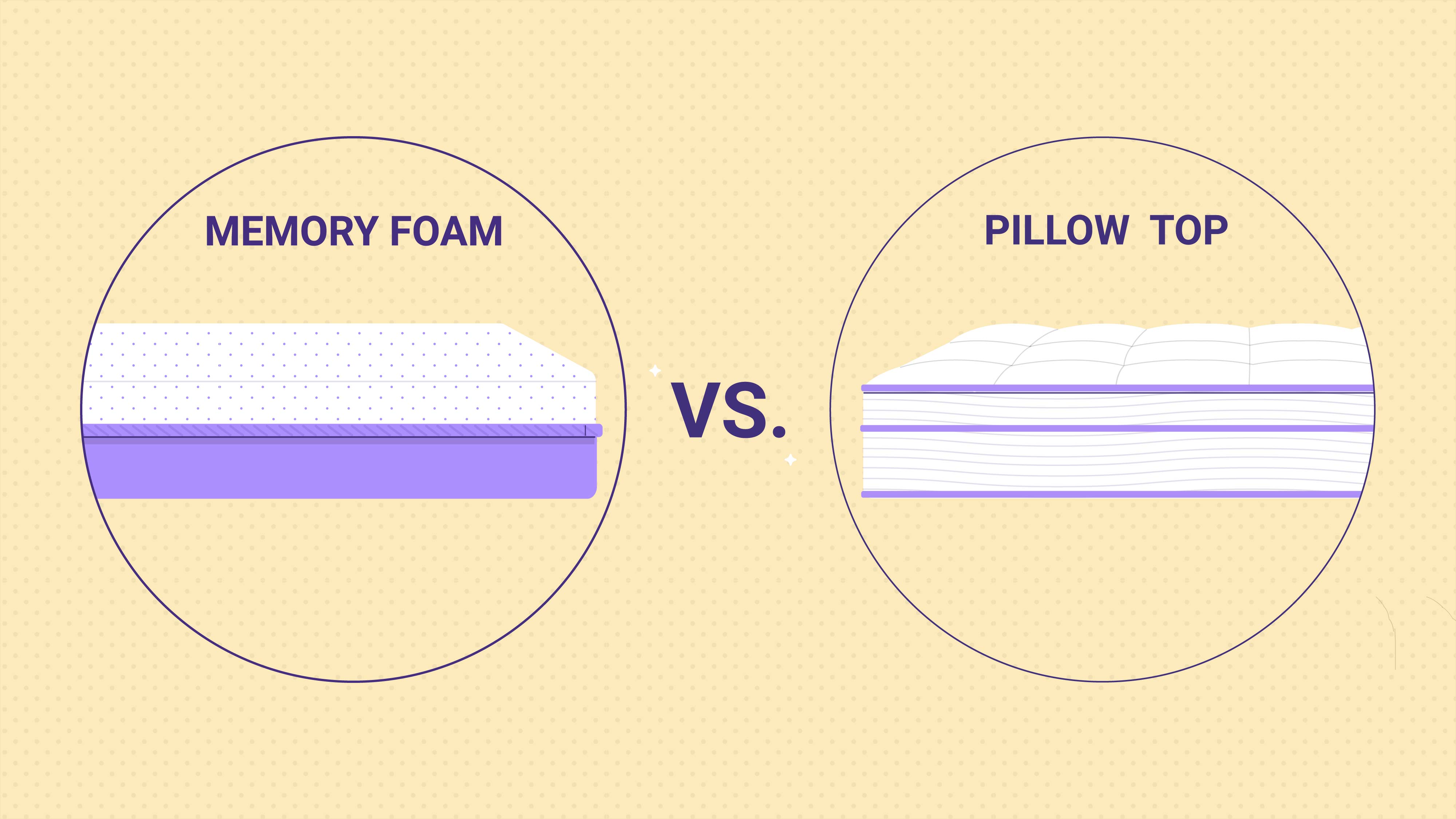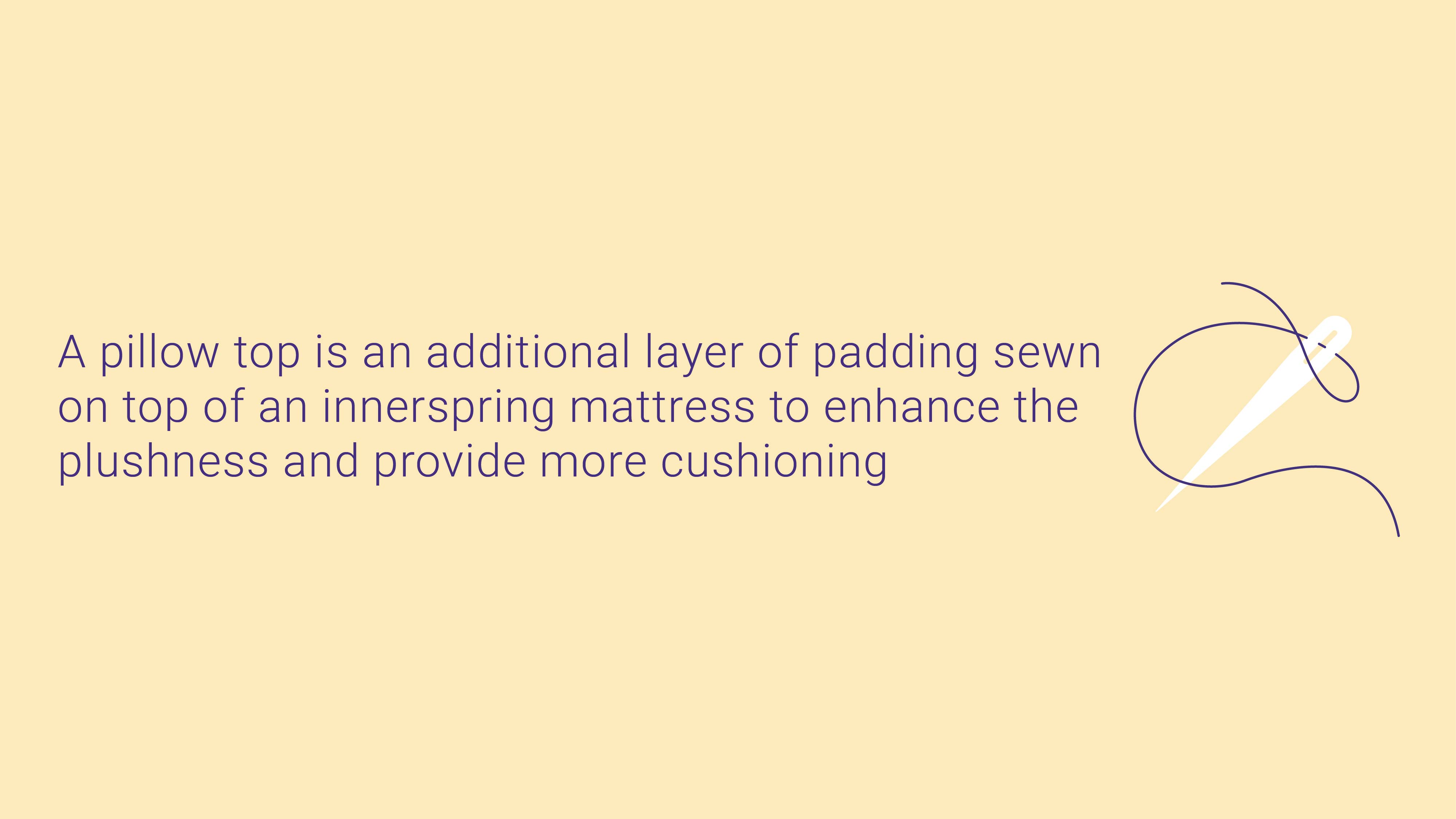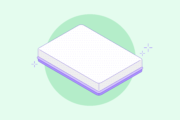
Memory Foam vs. Pillow Top – What’s the Difference?

- Memory foam mattresses excel in providing body-hugging comfort, deep pressure point relief, and easing muscle tension. They are durable, with a lifespan of up to ten years, making them a long-term investment. While they can retain heat, options with cooling infusions are available to enhance temperature regulation.
- Pillow-top mattresses offer an affordable option for those on a budget. They provide excellent airflow, dissipating body heat better than memory foam. Additionally, pillow tops undergo less off-gassing during manufacturing, reducing the new mattress smell.
- The choice depends on personal preferences. Memory foam suits those seeking contouring support, pressure relief, and a longer mattress lifespan. Pillow tops are suitable for budget-conscious shoppers and those who prioritize airflow but may lack contouring support and motion isolation.
Memory foam and pillow-top mattresses are both excellent options for sleepers looking for a plush bed. Both mattress types do a great job of relieving the pressure points and joint pain that cause you to toss and turn at night.
Although these mattresses offer cushioning support, they do have some differences. In this article, we’ll look at the distinct qualities of memory foam and pillow-top mattresses.
What is Memory Foam?
Memory foam is an innovation NASA developed to keep astronauts extra comfortable during take-off. Now, memory foam beds provide body-hugging comfort and offer a plush surface for a better night of rest. Memory foam is known for its soft, slow-reacting feel.
When you lie on a memory foam mattress, the material conforms to the shape of your body. This provides you with deep pressure point relief and eases muscle tension. Additionally, memory foam beds promote a neutral spine, making them a popular choice for back pain sufferers.
Advantages of Memory Foam Mattresses
Memory foam has unique properties specifically designed to enhance your sleep. Its ability to contour to the curves of your body is a favorite among sleepers. These beds are fantastic for minimizing pressure and reducing joint pain.
Another advantage of memory foam beds is they are durable. Unlike other mattress types, memory foam has thick durable layers to support your mattress. Memory foam mattresses last for up to ten years and usually have a longer lifespan than spring beds.
Disadvantages of Memory Foam Mattresses
High-quality memory foam mattresses are expensive. Queen-size beds usually range between $600 to $4000. It’s best to steer clear of cheap memory foam mattresses because they are often made with low-quality materials and may not last as long.
Memory foam products retain a lot of heat and may cause some sleepers to wake up feeling sweaty. Keep an eye out for memory foam beds with cooling infusions like gel or graphite. These items can be a bit more expensive, but they might be able to keep your sleeping environment cool and comfy.
Lastly, memory foam goes through an off-gassing process and may cause your mattress to smell a bit funky once you receive it. Off-gassing is a term that describes the release of gases, chemicals, and volatile organic compounds (VOCs) into the air from household items like your mattress.
Releasing gases into your home is not the best for your health and can be dangerous at high levels, so it is better to choose a memory foam bed with minimal VOC levels.
What is a Pillow Top Mattress?

A pillow top is an additional layer of padding sewn on top of an innerspring mattress to enhance the plushness and provide more cushioning. Typically, pillow-top layers are composed of materials like cotton, wool, down, fiberfill, memory foam, or latex foam.
There are two types of pillow top mattresses: Euro-top and traditional pillow tops. With traditional pillow tops, the material is sewn on top of the bed and has a noticeable gap above the comfort layer for extra padding. In Euro tops, the fabric is under the mattress cover with no gaps in between, providing better edge support.
See Also: Memory Foam vs Wool Pillow
Advantages of Pillow Top Mattresses
Pillow top mattresses are less expensive and better for tighter budgets. Most shoppers can find a quality queen bed from anywhere between $200 to $2000.
Pillow top mattresses also provide excellent airflow and dissipate body heat better than memory foam. Also, these beds go through less “off-gassing” during the manufacturing process, so they may not have that new mattress smell.
Disadvantages of Pillow Top Mattresses
There are a few drawbacks of purchasing a pillow-top mattress, one being they do not have contouring support like memory foam. Pillow top beds are also not the best choice for couples because they are not good at motion isolation. This may cause more sleeping interruptions to occur throughout the night and even disrupt your partner’s rest, though it is possible to find a mattress for motion isolation with a pillowy surface.
Furthermore, pillow-top mattresses have a coil support layer that is prone to wear and tear. It’s common for pillow-top mattresses to sag within the first few years of using them. Overall, this undermines the support of your bed and will ruin your sleeping quality.
FAQS
Is memory foam good for hot sleepers?
Memory foam beds are not always the best choice for hot sleepers because they tend to retain more heat than others, causing you to wake up feeling sweaty. Some alternatives are memory foam mattresses with cooling technologies, like plant-based or gel foam, to provide more airflow and cooling capabilities.
Which is better if I have allergies, memory foam or pillow top?
Allergy sufferers are better suited for memory foam mattresses. Memory foam can establish a hypoallergenic mattress, creating an unfriendly environment for mold, mildew, allergens, and dust mites. During manufacturing, these beds go through extensive processing and washing to ensure they resist common allergens.
Do pillow top mattresses sag easily?
Pillow top mattresses are not as durable as other mattress types and are prone to sagging. During initial use, pillow-top beds are effective in offering pressure point relief and cushioning for better sleep.
However, these benefits may not continue beyond the first couple of years. Some pillow top owners may start to see sagging within the three years of their purchase.
How many inches of memory foam is best?
Memory foam beds are typically composed of a memory foam layer and one or two other foam layers. Mattress thickness varies depending on the type of mattress. The best memory foam mattresses are at least 10 inches or thicker. A bed thinner than 10 inches is more likely to sag and may not withstand the pressure of your body weight.
What are hybrid mattresses?
Hybrid mattresses combine the qualities of innerspring and memory foam beds. Most hybrid beds have a thick poly-foam base layer, a support layer of pocketed coils, a transition layer of firm foam, and a comfort layer made with more responsive foam.
More sleepers are looking at hybrid mattresses because they may reduce some of the drawbacks of both innerspring and memory foam beds. For example, most sleepers do not like that innerspring beds have limited contouring. Others dislike memory foam beds because they are not as responsive.
The spring support system in a hybrid mattress adds bounce to your bed and promotes good airflow through the mattress. Additionally, foam layers help reduce the motion transfer while also conforming to your body, offering maximum pressure point relief.
Conclusion
Choosing the perfect mattress for your sleep needs ultimately comes down to personal preference. Some people may prefer the responsiveness and springy feel of a pillow-top mattress. Not to mention, pillow-top beds are an affordable choice for shoppers on a budget.
On the other hand, memory foam beds are an excellent choice for sleepers who like contouring comfort. Memory foam beds offer some of the best pressure point relief and may even include cooling technologies to keep you from overheating at night.



